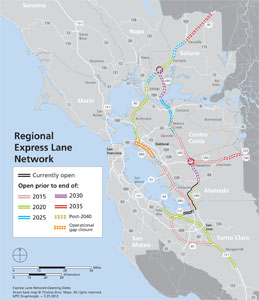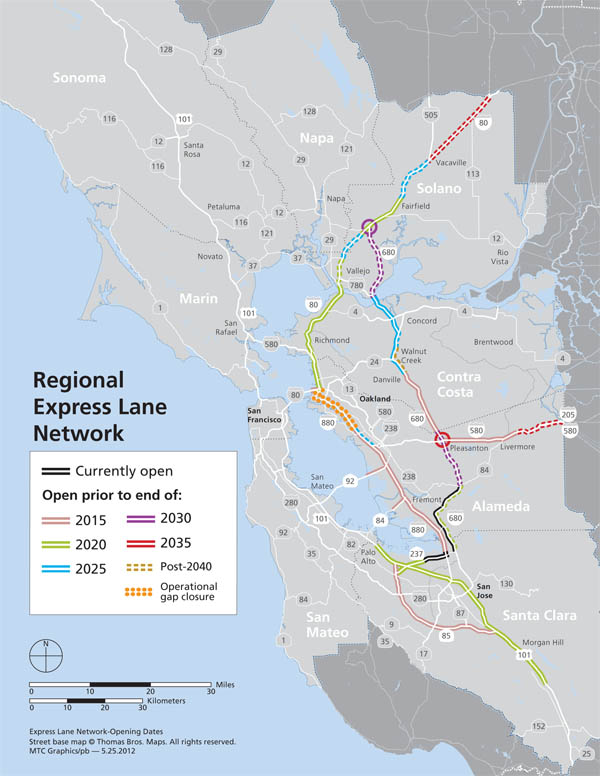Marking the biggest advance in Bay Area freeway operations since the launch of the FasTrak electronic tolling system, the Metropolitan Transportation Commission (MTC) is now moving to add 290 miles of Express Lanes to the regionís freeways in the coming years.

Tolls for solo motorists who use Express Lanes are paid via FasTrak and vary according to real-time traffic conditions. Photo by Noah Berger
By John Goodwin
Published: July, 2012
Marking the biggest advance in Bay Area freeway operations since the launch of the FasTrak electronic tolling system, the Metropolitan Transportation Commission (MTC) is now moving to add 290 miles of Express Lanes to the region’s freeways in the coming years. The new Express Lanes will be established primarily along the Interstate 80, 680 and 880 corridors in Alameda, Contra Costa and Solano counties, as well as the East Bay approaches to and from the Dumbarton and San Mateo-Hayward bridges.
Also known as high-occupancy/toll lanes, Express Lanes allow solo drivers who choose to pay a toll to take advantage of unused capacity in high-occupancy vehicle lanes. Tolls, which are paid electronically via FasTrak, vary with congestion levels to keep the lanes free-flowing at speeds of 45 miles per hour or higher. Carpools, buses, motorcycles and qualifying low- or zero-emission vehicles with valid access stickers will continue to have toll-free access to the Express Lanes.
The California Transportation Commission last fall greenlighted MTC’s proposal to add 290 miles of Express Lanes to the 280 miles of Express Lanes already authorized under state law in Alameda, Santa Clara and San Mateo counties to create a seamless regional network totaling 570 miles by 2035. Plans call for the conversion of 150 miles of existing carpool lanes plus select freeway widening projects to accommodate another 120 miles of new Express Lanes. The remaining 20 miles involve both directions of Interstate 880 through Oakland — a corridor that cannot physically accommodate Express Lanes per se, but is targeted for a variety of advanced operational strategies to smooth traffic flows.
Though transportation agencies in Orange and San Diego counties have operated Express Lanes for more than a decade, and similar lanes also have been established in metro areas as diverse as Denver, Houston, Minneapolis/St. Paul and Seattle, the Express Lane concept is still somewhat novel for many Bay Area drivers. The region’s fledgling network took a small but important step forward this spring with the Santa Clara Valley Transportation Authority (VTA)’s late March opening of a three-mile Express Lane segment connecting Interstate 880 and State Route 237. This marked the first new addition since Express Lanes made their Bay Area debut in late 2010 along a 14-mile stretch of southbound Interstate 680 over the Sunol Grade from State Route 84 to State Route 237. The next additions are slated for Interstate 580 in eastern Alameda County, State Route 85 in Santa Clara County and U.S. 101 in Santa Clara and San Mateo counties.
The Transportation 2035 Plan adopted by MTC in 2009 calls for using Express Lane revenues to close gaps in the Bay Area’s existing carpool lane system in order to:
• boost travel time savings for carpools and buses
• increase the efficiency of freeway operations; and
• provide reliable, congestion-free transportation.
"Express Lanes provide a form of congestion insurance," explained Alameda County Supervisor and MTC Commissioner Scott Haggerty. "Usage data shows that the typical solo driver in the I-680 Express Lane uses the lane just once or twice a month. We presume these customers are using the adjacent toll-free lanes on other days, and that they opt to use the Express Lane when they absolutely, positively can’t afford the unpredictability that comes with congestion."
MTC expects capital costs for the design, construction and operation of the 290-mile regional Express Lane network to total $3 billion to $3.6 billion, depending on the speed of implementation. While it is far too early to determine actual toll rates, MTC’s analysis shows the new Express Lanes will be financially feasible based on toll rates of 14 cents to $1 per mile in 2020. This range is comparable to current tolls on the I-680 Express Lane, where the average peak-period toll for the entire 14-mile corridor is $3, and on the State Route 91 Express Lanes in Orange County, where tolls average $10 for 10 miles.

Image courtesy of MTC


